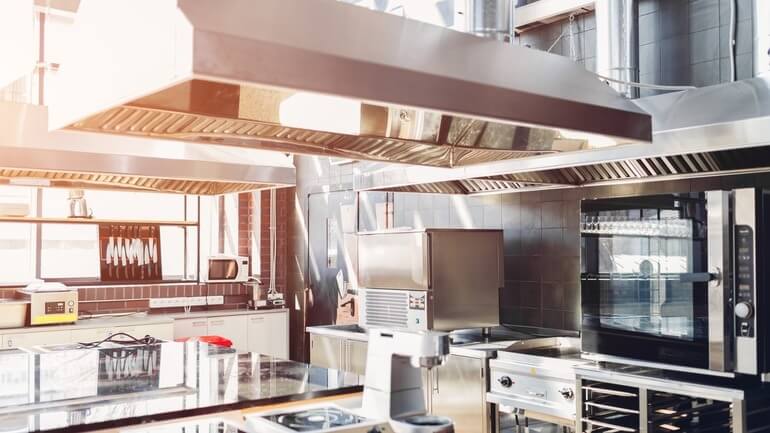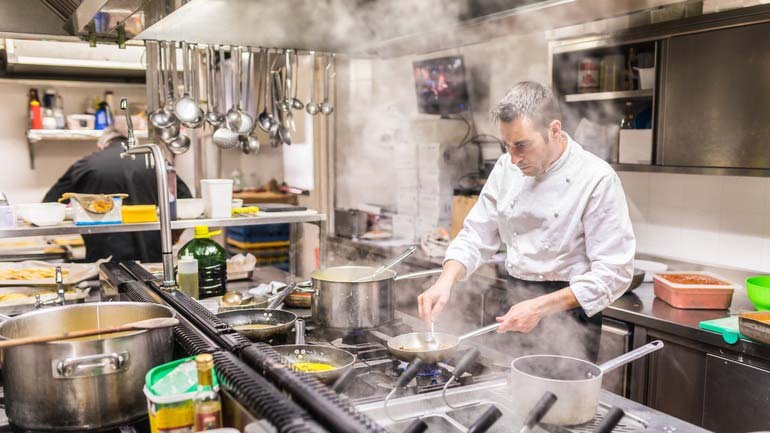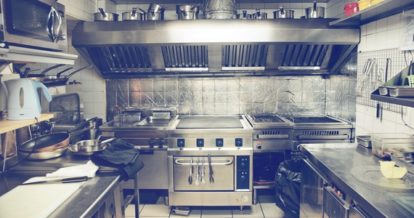The pandemic underscored the importance of having good air quality in restaurants, and many have recently upgraded their restaurant HVAC systems.
According to the CDC, newer – or even just well-maintained – HVAC systems can improve ventilation by increasing the introduction of clean air into a space and diluting harmful particles in the air. And while improving air quality is one of the best reasons to upgrade your HVAC system, there are other reasons – indicated by easy-to-spot signs – that it’s time to make changes to your existing heating, ventilation, and air conditioning set up. Missing these signs could not only cause uncomfortable dining and working conditions, but it may even put your team and guests in danger.
Though you should always consult an HVAC professional before upgrading your system, use this guide to gain a foundational understanding of:
- What a restaurant HVAC system is
- What a makeup air unit is
- Why restaurant HVAC systems are so important
- Signs it’s time to upgrade your HVAC system
What Is a Restaurant HVAC System?
A restaurant HVAC system is a commercial heating, ventilation, and air conditioning system used in restaurants. While people sometimes use “HVAC” and “AC” interchangeably, “AC” just refers to cooling of the air.
HVAC systems control the temperature of your venue, and promote the proper circulation and ventilation of air in a space. A restaurant’s system can be comprised of multiple parts, such as:
- A furnace for heat
- Ventilators for promoting air circulation
- Air conditioning units for cooling the air
- Makeup air units for replacing air exhausted by kitchen hoods
- Ductwork for circulating hot and cold air
- A thermostat for controlling your space’s temperature
You may be familiar with many of these components from your home’s HVAC system. The primary difference between what you may find at home versus what’s used in a restaurant is the size of the system. Commercial HVAC systems are larger than home systems because they service larger spaces.
Keep in mind that regular maintenance is critical to ensuring that your restaurant’s HVAC system is working as it should. Maintenance by an HVAC professional can help prevent dangerous problems that can interrupt business and make insurance premiums go up – situations that no restaurateur wants to deal with.
What Is a Makeup Air Unit?
One part of a restaurant HVAC system you may not be familiar with from your home’s system is a makeup air unit. Makeup air units should not be overlooked because they are a critical part of the HVAC system for restaurants.
A makeup air unit replaces the air exhausted from exhaust hood fans in the kitchen with fresh, temperature-controlled air from outside. In other words, it “makes up” the air removed from the hood. If you haven’t noticed a makeup air unit in your restaurant, check the roof; that’s where they’re typically installed.
Restaurant makeup air units are important for improving indoor air quality, removing airborne pollutants and contaminants, making your kitchen less stuffy, and preventing food smells from entering neighboring spaces. Because they add new, clean air to a space, having a good quality makeup air unit is especially important during the pandemic.
Why Restaurant HVAC Systems Are So Important
HVAC systems are the unsung heroes of many commercial spaces, including restaurants. They’re critical to maintaining good indoor air quality, making guests feel comfortable, improving working conditions in the kitchen, and more.
Below are just a few of the reasons to invest in a high-quality restaurant HVAC system.
Improve Ventilation and Air Filtration
Since the beginning of the pandemic, there has been heightened importance on restaurant cleaning and ventilation. An upgraded HVAC system can help you maximize air quality in your restaurant by improving ventilation and filtration.
Ventilation, makeup air, and air conditioning units circulate air throughout your restaurant. They work together to create a safe and comfortable environment for diners and staff.
Additionally, and most importantly, filtration helps remove airborne pollutants and contaminants. After all, unventilated air can breed viruses, mold, and bacteria.
Control Kitchen Temperatures and Air Quality

Kitchens are known for getting hot and stuffy – the air gets filled with smoke from the stove, grease from the fryer, and heat from the oven. Without proper HVAC equipment, kitchens can be uncomfortable – and dangerous – places to work.
Exhaust hoods and makeup air units make kitchen air less stifling, while air conditioning units cool the air to make it more comfortable to work in. Finally, ventilators keep unhealthy, smoky air from impeding staff’s health and performance. As a result, HVAC systems are critical to creating a safe work environment for your back-of-house team.
Restrict Odors
Everyone loves delicious food smells, but diners probably don’t want to leave your restaurant smelling like fried onions, or choking on smoke from the kitchen. Exhaust hoods and makeup air units prevent food smells from seeping from the kitchen into the dining room, creating a better atmosphere for both guests and employees.
Reduce Energy Loss
Professionally-installed HVAC systems are designed to efficiently control air temperature. They help you keep cold air in when it’s hot outside, and warm air in when it’s cold outside.
For example, central air conditioning units are more efficient than fans. Air conditioning systems temper air, while fans simply recirculate the same air.
Plus, the latest HVAC systems have energy-saving smart thermostats that let you control temperatures remotely, and learn your behavior to strike a balance between comfortable air temperatures and lower bills. Money-saving features like this are especially important during slower months, when demand for restaurants is lower than normal and increasing efficiency is critical to business longevity.
Lower Risks Associated with Depressurization
The depressurization of air within a building is a little known risk to those outside of the HVAC industry. Depressurization is what happens when too much air is taken out of your space through an exhaust hood, but the air isn’t replaced. Negative air pressure can be dangerous.
Depressurization can allow toxic gases like carbon monoxide (CO) to flow inside your space instead of escaping it, which can give your staff and guests headache-inducing carbon monoxide poisoning. Make sure your makeup air system is properly functioning to avoid depressurization and keep everyone safe.
Keep Diners Safe and Comfortable
Perhaps the biggest benefit of restaurant HVAC systems is that they provide diners with a safe and comfortable environment.
Air circulation and ventilation give diners peace of mind by filtering out airborne contaminants like viruses and mold. Advertising to guests that you recently upgraded your HVAC system may make them more willing to dine at your restaurant because they know that you’ve invested in improving your indoor air quality.
Beyond safety, heating and air conditioning helps to keep diners comfortably warm in the winter and cool in the summer. While we’re on the subject: don’t forget to winterize your restaurant’s patio to let guests dine outdoors year-round – outdoor heaters are a must!
Additionally, proper exhaust reduces smells from escaping from the kitchen and overwhelming diners. Guests shouldn’t leave your restaurant smelling like lunch!
And finally, proper air pressurization keeps guests safe from CO poisoning, which is a win-win for your diners, who won’t go home with a headache, and for your business, which will avoid lawsuits.
While HVAC systems are often overlooked, there’s no question that they play a critical role in regulating your restaurant’s environment.
9 Signs You Should Upgrade Your Restaurant’s HVAC System
Now that you know all the benefits of a good HVAC unit you might be considering upgrading your current restaurant HVAC system. If you need more impetus to call an HVAC professional ASAP, here are a few more reasons to make improvements to your system.
If you notice any of these nine signs at your venue, don’t ignore them. Left unresolved, these problems could lead to major safety concerns.
1 . System Not Working
First things first, if your restaurant HVAC system is no longer working like it’s supposed to, it’s definitely time to get it checked out, especially since that may be a sign of something bigger than a mechanical issue.
For example, if your furnace’s pilot light can’t start, the air in your restaurant may be depressurized, which is a critical health concern.
2. Mechanical Damage
If you notice physical damage to your vents, ducts, air conditioning units, furnace, or other parts of your HVAC system, they should be addressed immediately by an HVAC professional. A DIY fix may cause more problems.
3. Chimneys Not Drafting Properly
If you notice 1) air coming inside of your restaurant from your chimney, 2) your carbon monoxide alarm going off, or 3) guests or staff complaining about headaches (a sign of carbon monoxide poisoning), you could have a dangerous backdraft coming from your chimneys caused by a depressurization of air in your restaurant.
If you notice this issue, don’t delay getting it addressed. Backdrafts bring toxic gases and air inside your space instead of taking it out.
4. Negative Air Pressure
If your space is dealing with a negative air pressure issue, you’ll notice drafts and that your doors are suddenly more difficult to open. If this is the case, you’ll probably need your makeup air unit fixed or replaced.
5. Imbalanced Temperature
Are some areas of your restaurant oddly cooler than others? No, you probably don’t have a ghost haunting you. You could have issues with your restaurant HVAC system. Imbalanced temperatures in places where they don’t make sense could be a sign of an HVAC problem.
6. Smokier Kitchen and Increased Grease Build-Up

If your kitchen is smokier than usual, or more grease is building up on surfaces, these are signs that your exhaust hood and makeup air unit aren’t working well. Get them looked at ASAP to ensure a safe working environment for your cooks.
7. Increased Humidity
Some amount of humidity is normal in certain regions, but if you notice an unusual change in the humidity within your restaurant, it could indicate a problem with your air system.
8. High Energy Bills
If your energy bills are much higher than they were this time last year, you could be dealing with a whole host of problems in your restaurant. Your ductwork could be leaking out air, your insulation may be ineffective, or your windows may be improperly sealed. Call an HVAC professional to inspect ductwork and insulation so you can lower your operating costs.
9. Smells Where You Don’t Want Them
A certain amount of food aromas are expected in any restaurant, but they should be mostly contained to the kitchen. If your dining room smells like your kitchen, that’s a sign of improper ventilation. Your exhaust fans might be broken or your venue may not be getting enough makeup air.
Is It Time to Upgrade My Restaurant HVAC System?
There are many reasons why you might upgrade your restaurant HVAC system. Doing so may give diners peace of mind that your restaurant is doing everything possible to create a safe environment with good air quality. And if you notice signs of mechanical damage, poor insulation, or negative air pressure, upgrading your HVAC system right away is crucial to keeping staff and guests safe.
Download our free inventory template
Sign up for our free weekly TouchBistro Newsletter







